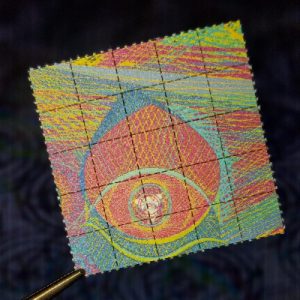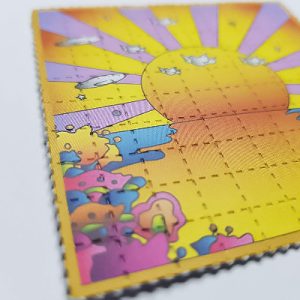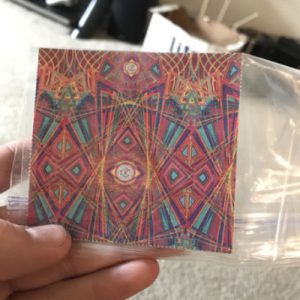LSD Products for Sale on the Dark web
LSD, or lysergic acid diethylamide, is a powerful hallucinogenic drug that belongs to a class of substances known as psychedelics. It is derived from lysergic acid, which is found in the ergot fungus that grows on grains like rye. LSD is famous for its potent hallucinogenic effects, altering perception, mood, and thought processes. Here are some key points about LSD:
Chemical Structure: LSD is a synthetic compound, and its chemical structure is similar to serotonin, a neurotransmitter involved in mood regulation, perception, and sleep.
Psychoactive Effects: LSD is known for its hallucinogenic properties, which typically include alterations in sensory perception, visual and auditory hallucinations, and changes in the perception of time. Users may also experience a heightened sense of introspection and a feeling of interconnectedness.
Dosage: LSD is potent, and even small doses (measured in micrograms) can produce profound effects. Dosages can vary, and the effects may last for several hours.
Mode of Administration: LSD is commonly ingested orally, usually on blotter paper that has been soaked with the liquid form of the drug. It can also be found in the form of tablets, gelatin squares, or as a liquid.
Set and Setting: The effects of LSD can be highly influenced by the user’s mindset (set) and the environment in which they take the drug (setting). A supportive and calm setting is often recommended to minimize the risk of a challenging or negative experience.
History: LSD was first synthesized by Swiss chemist Albert Hofmann in 1938. Its psychoactive properties were later discovered in 1943 when Hofmann accidentally ingested a small amount of the substance. In the 1950s and 1960s, LSD gained popularity and was explored for its potential therapeutic uses. However, due to concerns about its recreational use and potential side effects, it was criminalized in many countries.
Legality: LSD is classified as a Schedule I controlled substance in the United States and is illegal in many countries. Schedule I substances are considered to have a high potential for abuse, no accepted medical use, and a lack of accepted safety for use under medical supervision.
Therapeutic Research: In recent years, there has been a resurgence of interest in researching the therapeutic potential of LSD and other psychedelics for conditions such as depression, anxiety, and PTSD. Clinical trials are exploring controlled and guided administration of these substances in therapeutic settings.
It’s important to note that the use of LSD can have unpredictable effects, and it is associated with both potential risks and benefits. Unsupervised and recreational use can lead to adverse reactions, and individuals with a history of mental health issues should exercise caution. If considering the use of LSD for therapeutic purposes, it should only be done under the guidance of trained professionals in a controlled setting.
LSD for Sale
-
Rated 4.80 out of 5 based on 5 customer ratings$140.00
-
Rated 4.40 out of 5 based on 5 customer ratings$170.00
-
Rated 4.60 out of 5 based on 5 customer ratings$250.00
-
Rated 4.00 out of 5 based on 5 customer ratings$100.00
-
Rated 4.80 out of 5 based on 5 customer ratings$150.00
-
Rated 3.80 out of 5 based on 5 customer ratings$125.00
History of LSD
The history of LSD (lysergic acid diethylamide) is intertwined with scientific discovery, medical research, counterculture movements, and legal controversies. Here is an overview of key events in the history of LSD:
Discovery by Albert Hofmann (1938): LSD was first synthesized by Swiss chemist Albert Hofmann in 1938 while he was working for the pharmaceutical company Sandoz. Initially, Hofmann was investigating compounds derived from ergot fungus, and LSD was set aside until 1943.
Accidental Ingestion by Albert Hofmann (1943): On April 16, 1943, Hofmann accidentally ingested a small amount of LSD. This event, known as Bicycle Day, marked the first intentional LSD trip. Hofmann experienced hallucinations and altered states of consciousness.
Medical and Psychiatric Research (1950s-1960s): Sandoz Laboratories began distributing LSD for medical and psychiatric research. Researchers, including psychiatrists such as Humphry Osmond and Stanislav Grof, explored its potential therapeutic uses, particularly in psychotherapy and treatment of various mental health conditions.
Psychiatric Treatment and Mind Expansion (1950s-1960s): During this period, some psychiatrists believed that LSD could facilitate breakthroughs in psychotherapy and the treatment of conditions such as alcoholism and schizophrenia. Meanwhile, outside of medical settings, LSD gained popularity as a tool for expanding consciousness and self-exploration.
Timothy Leary and the Counterculture (1960s): Timothy Leary, a psychologist, and Richard Alpert (later known as Ram Dass) conducted controversial research on psychedelics at Harvard University. Leary famously advocated for the use of LSD, popularizing the phrase “Turn on, tune in, drop out.” LSD became associated with the emerging counterculture movement of the 1960s.
Criminalization and Legal Restrictions (1960s): Due to concerns about the recreational use of LSD and its association with the counterculture, many countries began criminalizing its possession and use. In 1966, the United States classified LSD as a Schedule I controlled substance.
Banning of LSD (1970s): Sandoz stopped producing LSD in 1965, and its legal status as a therapeutic tool declined. By 1970, LSD was banned in most countries, limiting research opportunities.
Resurgence of Research (21st Century): In recent years, there has been a resurgence of interest in psychedelic research, including LSD. Clinical trials are exploring the therapeutic potential of LSD in controlled settings for conditions such as anxiety, depression, and post-traumatic stress disorder (PTSD).
Current Legal Status: LSD remains illegal in many countries, including the United States, where it is classified as a Schedule I controlled substance. Some exceptions exist for research purposes in controlled environments.
The history of LSD reflects its complex journey from a scientific discovery with potential therapeutic applications to its association with the counterculture and subsequent legal restrictions. Ongoing research is exploring the potential benefits of LSD in a more controlled and clinical context.
How to identify LSD Products
Identifying LSD products, especially in illicit or non-medical settings, can be challenging because the substance is typically distributed in small, colorless, odorless, and tasteless forms. The most common form of LSD is on blotter paper, which is often decorated with colorful designs and perforated into small squares. Here are some considerations:
Blotter Paper: LSD is commonly sold on blotter paper. Each square of blotter paper is often a single dose, and it may have various designs or images. The paper itself is typically tasteless and odorless.
Liquid Form: LSD can also be found in liquid form, which is sometimes applied to sugar cubes, gelatin, or candies. The liquid may have no color or be slightly tinted, but it is usually difficult to discern with the naked eye.
Microdots: In some cases, LSD may be sold as tiny pills known as microdots. These are small, round tablets that can vary in color, but they are typically very small and may be difficult to identify without specialized equipment.
Dosing Levels: LSD is active in very small amounts, measured in micrograms (millionths of a gram). A typical dose is around 100-150 micrograms. However, determining the dosage by visual inspection alone is impossible.
Testing Kits: If you suspect that a substance may be LSD, various drug testing kits are available that can help identify the presence of the drug. These kits often involve applying a small sample of the substance to a testing strip or liquid and observing a color change based on the presence of LSD.
Legal Status: In many places, LSD is a controlled substance, and its possession, distribution, and use are illegal. In some cases, law enforcement may use specialized testing equipment to identify the presence of LSD.
Risk of Misrepresentation: It’s crucial to note that substances sold as LSD may sometimes be misrepresented, and users might unknowingly consume other substances. Therefore, testing the substance using a reliable testing kit is recommended for harm reduction.
It’s important to approach any substance with caution, especially those with hallucinogenic properties. If someone is considering using LSD or any other psychoactive substance, it is advisable to prioritize safety, seek information from reliable sources, and be aware of the legal implications in their jurisdiction. Additionally, engaging in open and honest communication with healthcare professionals and avoiding the use of substances from unknown or untrusted sources is crucial for minimizing risks.
Effects of Consuming LSD
Consuming LSD (lysergic acid diethylamide) can lead to a wide range of psychoactive effects. The effects are highly dose-dependent, and individual responses can vary. LSD is known for its hallucinogenic properties, producing changes in perception, mood, and thought processes. Here are some of the common effects associated with consuming LSD:
Visual Distortions and Hallucinations: LSD is well-known for inducing visual alterations. Users may experience vivid colors, patterns, and geometric shapes. Objects may appear to warp or breathe, and users may see hallucinations that are not present in reality.
Altered Perception of Time: Users often report a distortion of time, with minutes feeling like hours or vice versa. The normal perception of time passing may be significantly disrupted.
Enhanced Sensory Perception: LSD can heighten sensory experiences, making colors appear more vibrant, sounds more intense, and tactile sensations more pronounced.
Changes in Thought Patterns: LSD can lead to unconventional or abstract thinking. Users may experience a stream of consciousness, with thoughts flowing rapidly and connections between ideas becoming more pronounced.
Elevated Mood: Many users report a sense of euphoria or intense happiness during an LSD trip. Positive emotions are commonly experienced.
Introspection and Self-Reflection: LSD can induce a heightened sense of self-awareness, leading to introspection and self-reflection. Users may gain insights into their emotions, behaviors, and life experiences.
Synesthesia: Some users may experience synesthetic perceptions, where sensory experiences become intertwined. For example, they may “see” music or “hear” colors.
Loss of Ego and Unity Consciousness: In some cases, users report a temporary loss of their sense of self (ego dissolution). This can lead to a feeling of unity with the universe or a sense of interconnectedness with others and the world.
Mood Swings: While euphoria is common, users may also experience mood swings, and intense emotional experiences, both positive and negative.
Physical Effects: LSD can have physiological effects, including increased heart rate, elevated blood pressure, dilated pupils, and changes in body temperature. Nausea is also a possible side effect, especially during the onset of the trip.
It’s important to note that the effects of LSD are unpredictable, and a “bad trip” characterized by anxiety, fear, or paranoia can occur. The set (mindset of the individual) and setting (environment) play crucial roles in shaping the overall experience.
Additionally, LSD is a powerful substance that can have lasting effects, and its use carries potential risks, including psychological distress and triggering underlying mental health issues. Responsible use, informed decision-making, and consideration of the legal status in one’s jurisdiction are essential when it comes to the use of psychedelic substances. If someone is considering using LSD, it is advisable to do so in a safe and controlled environment, ideally under the supervision of experienced individuals or professionals.
Legal Status of LSD
The legal status of LSD (lysergic acid diethylamide) varies around the world, and it is generally classified as a controlled substance due to its potent hallucinogenic properties. Here are some key points regarding the legal status of LSD:
United States: LSD is classified as a Schedule I controlled substance in the United States. This classification means that it is considered to have a high potential for abuse, no accepted medical use, and a lack of accepted safety for use under medical supervision. Possession, distribution, and use of LSD are illegal, and penalties for offenses can include fines and imprisonment.
International: LSD is controlled under international drug control treaties. The United Nations Convention on Psychotropic Substances classifies LSD as a Schedule I substance, meaning it is subject to strict controls and regulations.
European Union: LSD is illegal in most European countries, and its possession, distribution, and use are typically criminal offenses. However, specific laws can vary between countries, and some may have decriminalized small quantities for personal use.
Canada: LSD is listed as a Schedule III substance under the Controlled Drugs and Substances Act in Canada. This classification denotes that it is illegal to possess, produce, or distribute LSD. Penalties for offenses can include fines and imprisonment.
Australia: LSD is classified as a prohibited substance in Australia, and its possession, sale, or use is illegal. Penalties for offenses can range from fines to imprisonment, depending on the nature and severity of the violation.
United Kingdom: LSD is classified as a Class A drug in the United Kingdom, which is the highest category of controlled substances. Possession, production, and supply offenses are subject to severe legal penalties, including significant prison sentences.
Research Exemptions: While LSD is generally illegal for recreational use, there have been instances where researchers have been granted exemptions for controlled studies exploring the therapeutic potential of LSD. These studies are typically conducted in highly regulated and controlled environments.
It’s important to note that laws regarding controlled substances can change, and legal consequences for LSD-related offenses can vary by jurisdiction. The possession, distribution, or use of LSD outside of legal and regulated contexts can result in serious legal consequences. Individuals should be aware of and adhere to the laws in their specific region regarding the use of LSD or any other controlled substance. Engaging in responsible and informed decision-making is crucial when it comes to substances with psychoactive properties.
Where to Buy LSD Online
There are so many websites online that promise to sell Psychedelic Mushrooms online. Some of these websites deliver what they promise, others do not. If you are looking to buy psychedelic mushrooms online then look no further than dark web psychedelics website. In our shop, you will find a wide variety of psychedelic products, ranging from Mushrooms, LSD, MDMA and Ketamine We offer high quality psychedelic mushrooms carefully sourced from the best producers in the business of shrooms.
Contact us for more information on purchases. Our delivery system is discreet and 100% safe. Our clients safety and anonymity is our greatest priority.
Why buy LSD from Us
We offer a wide variety of Psychedelic Mushrooms and other psychedelic products. Our products are high quality and of very high purity. We offer free delivery for bulk orders and we take our clients security and anonymity seriously. Shipments are handled discreetly with our clients addresses well protected.






